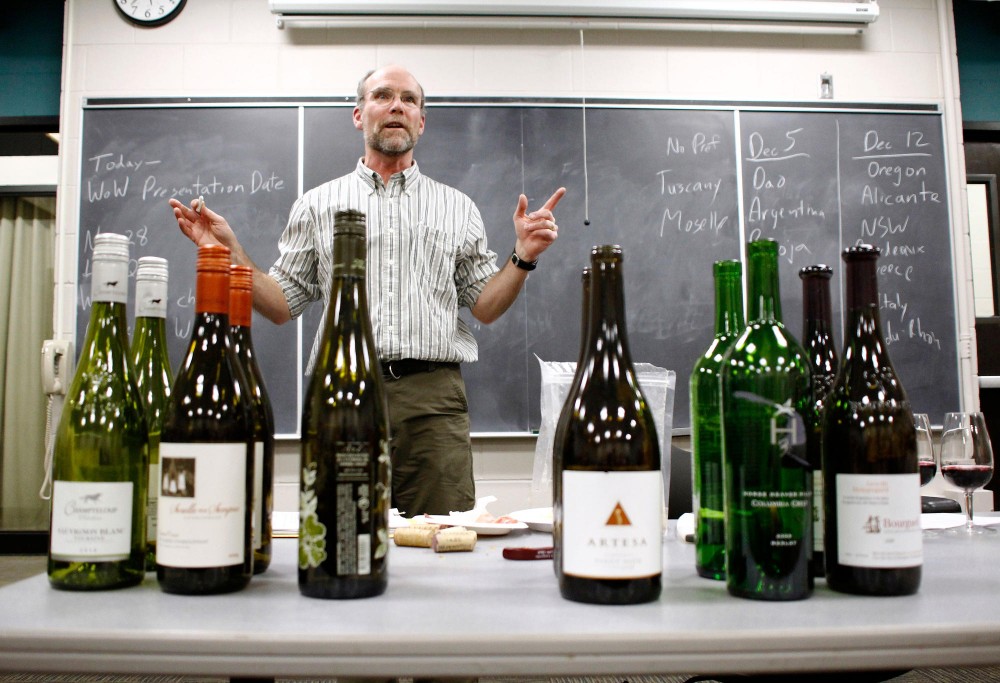In the past 30 years, the University of Minnesota has developed climate-enduring wine grapes that are now made into the four most widely produced wines in Minnesota.
A full crop of âÄúcold hardy grapesâÄù can withstand temperatures of up to 33 below zero.
Now, a $2.5 million grant from the U.S. Department of Agriculture will allow researchers from the University and scientists from 11 other institutions to research more climate-resistant wine grapes, the acidity and taste within wine grapes and how best to market the wine to consumers.
Professor James Luby of the Department of Horticultural Sciences said the wine industry has been progressively growing in Minnesota for the last 15 years.
âÄúItâÄôs a small industry, but there are now 33 wineries throughout the state and more than 1,000 acres of vineyards,âÄù Luby said.
Luby attributed the increase to consumer interest in buying locally grown crops.
A bulk of the wine grape plantings in the state consists of grapes developed by the University. The four varieties include Frontenac, Frontenac gris, La Crescent and Marquette.
At the UniversityâÄôs Horticultural Research Center near Victoria, Minn. âÄî about 25 miles southwest of Minneapolis âÄî research continues to be conducted on the different tastes. Last year, researchers produced 100 different kinds of wines for genetic or optimization trials, according to Katie Cook, an enologist at the center.
Cook said all wine is experimental and used for evaluation, not sale. Throughout the year, researchers conduct sensory and chemical evaluations, as well as tasting panels for both the wine and grapes.
Once the research center has produced a grape that generates a superior-tasting wine, it licenses the grapes to nurseries, which sell them to wineries.
Cook said she thinks the grant can really boost the wine industry as a whole.
âÄúI hope the industry gets more advanced knowledge of the grape and learn how to make wines better,âÄù Cook said. âÄúI think the industry needs to learn how to market toward consumers and get the consumers interested.âÄù
Cook said many consumers avoid new wines because theyâÄôre not familiar with them.
âÄúFlavors change over time and people adapt to flavors,âÄù Cook said. âÄúConsumers flock to flavors theyâÄôre accustomed to.âÄù
Luby is the professor of Horticulture 1031, Vines and Wines: Introduction to Viticulture and Enology, where students learn about how wine is produced, how to taste wine and its components and how to be an informed consumer.
Students must be 21 to take the class âÄî Luby checks I.D.s at the beginning of the first class âÄî and each week the class tastes a variety of different wines through sensory sessions.
âÄúTake a sip of Cabernet Franc, and swirl it around your mouth,âÄù Luby said to the class.
Monday nightâÄôs class involved a special wine and food pairing. Luby instructed the class to eat a certain food and wash it down with one of six wines in front of them. Many of the combinations resulted in bitter or sweet reactions from students.
âÄúFood and wine tastes compete against each other,âÄù Luby said.
Students Christina Perfetti and Katrina Kestler took the class after traveling to Spain together.
âÄúWhen we go to the liquor store, we no longer just pick out a pretty bottle,âÄù Kestler said. âÄúWe now buy wine based on their tastes and flavors from what we learned in this class.âÄù
Horticultural masterâÄôs student Luke Haggerty, whose thesis involves grape and berry development, said that more knowledge is needed about wine and wine growing.
âÄúWe need to be able to produce higher-quality wines,âÄù Haggerty said. âÄúWe need to learn more about our cultivars so we can use them in this frigid climate, both in the vineyard and in the winery.âÄù
As the Minnesota wine industry grows and develops, Haggerty said he hopes to see the industry prosper in the next few decades.
âÄúIn 30 years I would like to be able to compare the Minnesota wine industry to what the Oregon wine industry is today. Many smaller scale operations that are competitive, profitable and produce high-quality wines.âÄù








